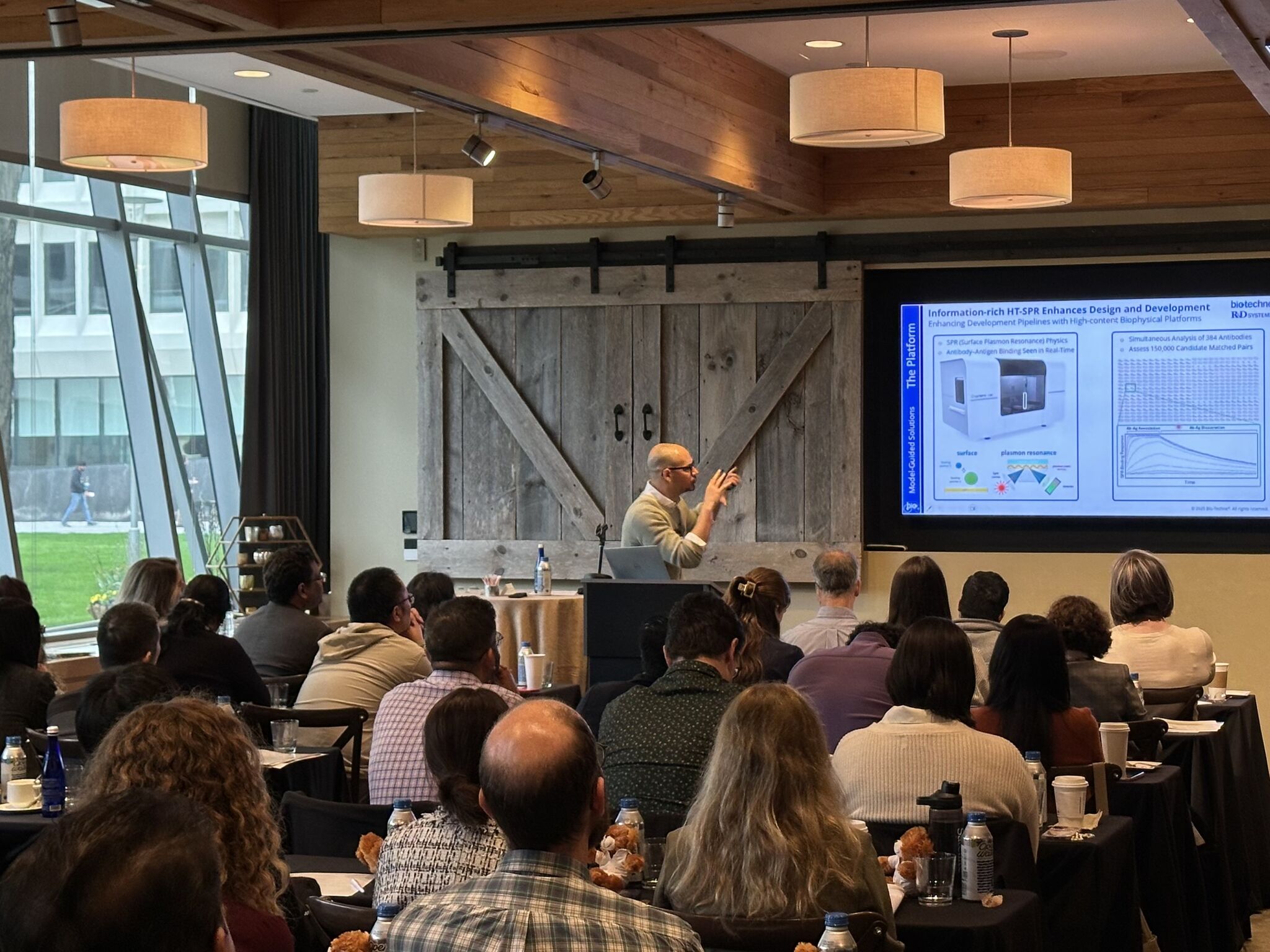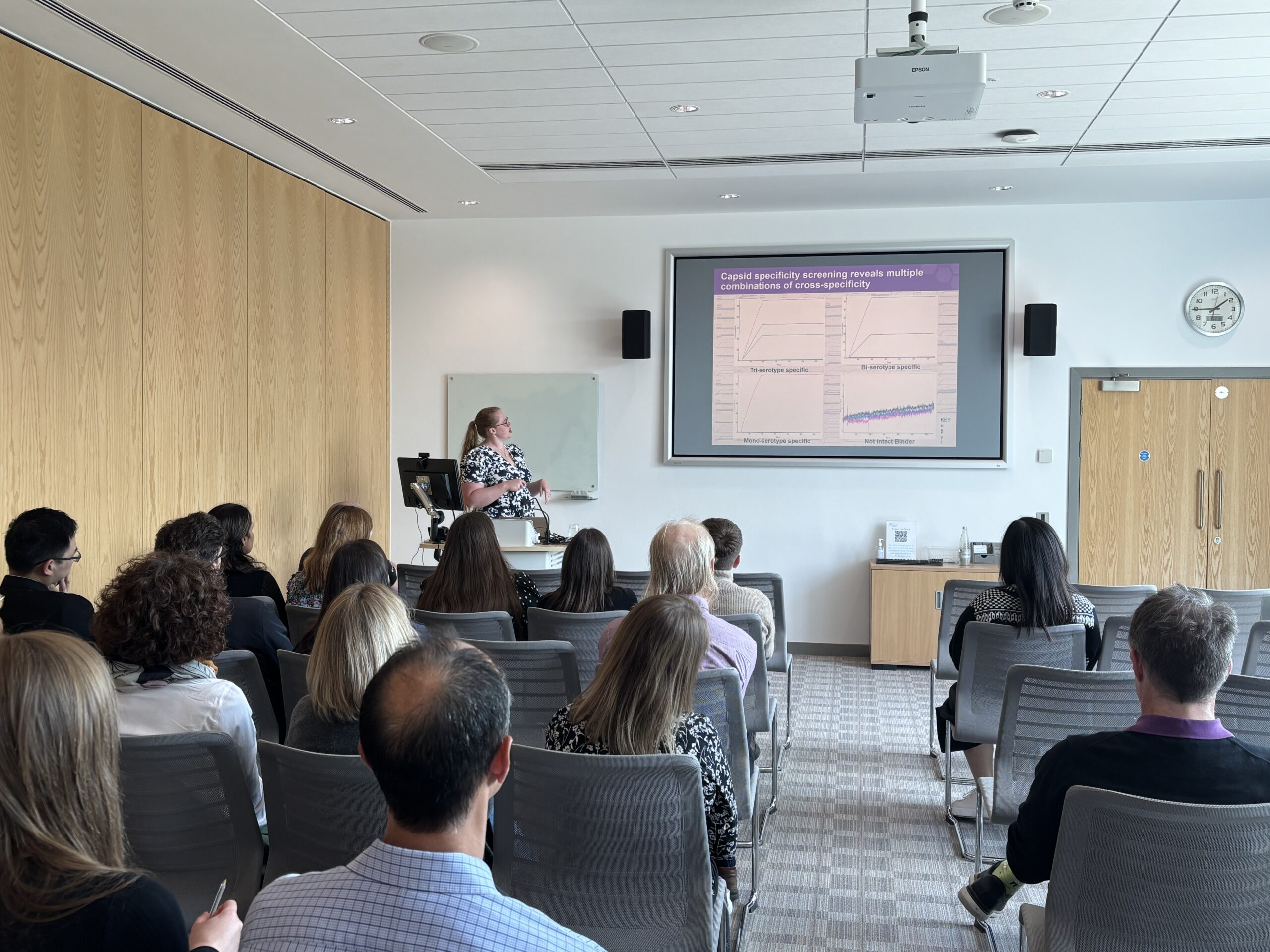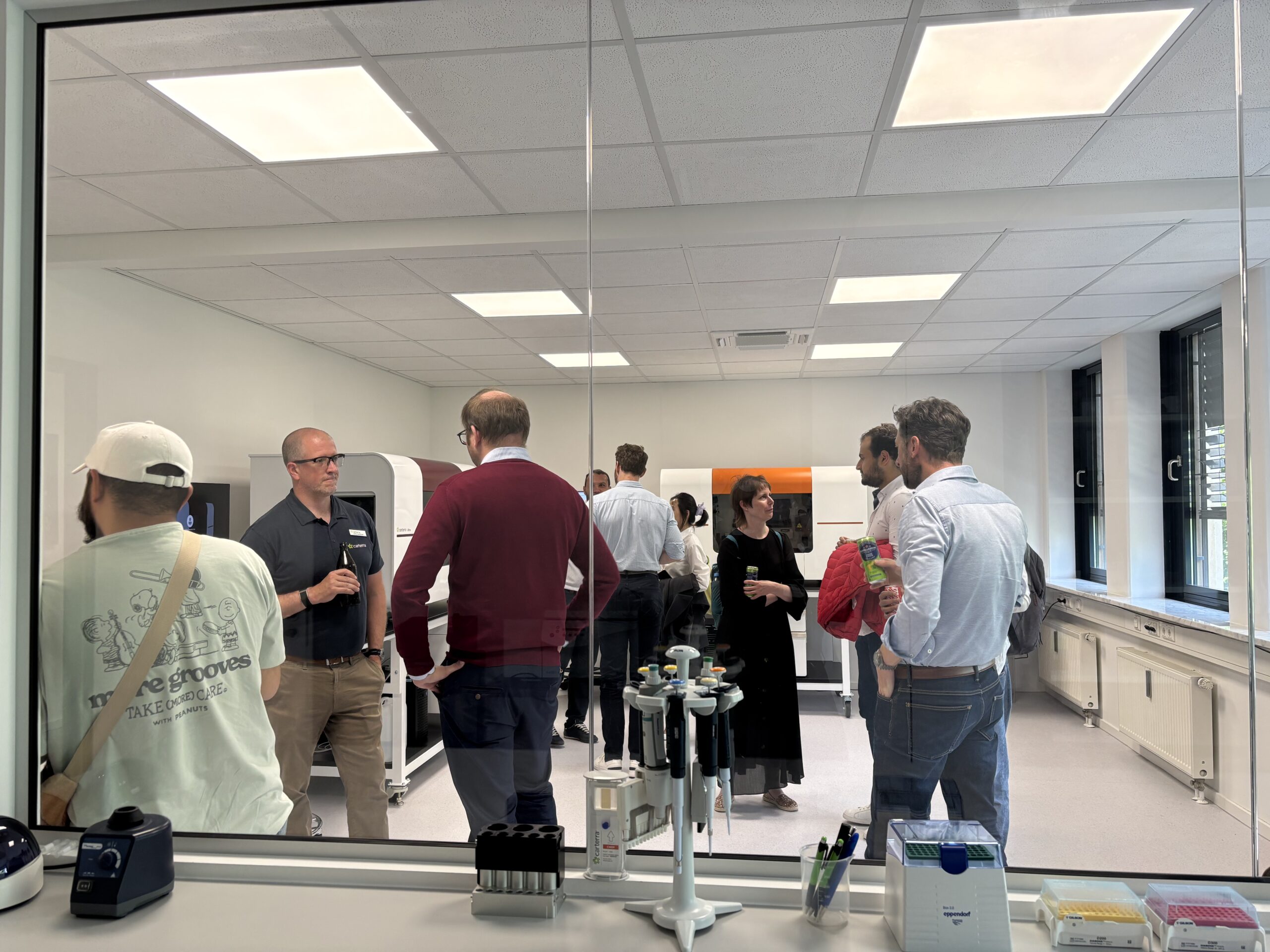Unlocking High-Throughput Biology in Drug Discovery – View Speaker Presentations
Industry and academic scientists presented new paradigms in discovery, applications and workflows including HT-SPR. Topics included:
- Machine Learning and AI Approaches for Protein Engineering
- Emerging Targets for Oncology and Beyond
- Engineering Bispecific and Multifunctional Antibodies
- Biophysical Characterization and High-Definition Epitope Binning Enabling Novel Biotherapeutic
The speakers included scientists from …

You can view slides from the presentations below.

James Fishburn, Senior Scientist, Pfizer
HT-SPR Evaluation of Critical Reagent Antibodies Yields Expected and Unexpected Benefits
Abstract: Antibody-drug conjugates (ADCs) are an important and growing class of oncologic therapeutics that have the potential for a broad therapeutic index and reduced immunogenicity in patients. These metrics are closely monitored in clinical trials using bioanalytical methods that employ critical reagents, which are frequently ADC-specific anti-idiotype (anti-ID) antibodies. At Pfizer, we utilize a Carterra LSA to evaluate our reagent candidates to ensure that there is accurate and specific detection of our ADCs. This process allows us to comprehensively understand the binding characteristics of each anti-ID, which subsequently guides our selection of the anti-ID reagents for use in the pharmacokinetic and immunogenicity assays of our experimental ADCs. This presentation details our evaluation methodology and its advantages, and shares an unexpected discovery of cooperatively binding anti-IDs that was enabled by the LSA.

Yadong Yu, PhD, Senior Research Scientist III, Curia
VHH Antibody Discovery for huCD200R1
Abstract: Nanobodies are a growing modality in antibody therapeutics, with FDA-approved treatments driving demand for VHH discovery. Their small size and typically longer CDR3 enables targeting challenging epitopes in solid tumors, overcoming limitations of larger antibodies. Here we used single B cell antibody discovery to rapidly identify a diverse set of potent, high affinity, neutralizing VHH from immunized llamas against CD200R1, an emerging therapeutic immune checkpoint target.

Deborah Moshinsky, PhD, Director of Antibody Characterization & Validation, Institute for Protein Innovation
High-throughput Recombinant Antibody Validation for Community Distribution
Abstract: The Institute for Protein Innovation (IPI) is a non-profit research organization providing recombinant antibodies to the biomedical community against understudied targets. Antibodies are produced using a yeast display platform, and rigorous QC and validation are performed to ensure highest quality. High-throughput surface plasmon resonance (SPR) is performed to assess binding affinity and kinetics, alongside polyreactivity, flow cytometry, immunofluorescence (IF) and other application assay testing. Cross-reactivity analysis ensures specificity among related proteins. Validated antibodies are distributed via Addgene, enabling broad scientific impact. This presentation highlights high-throughput SPR and antibody characterization using the Glypican protein family as an example.
 Sasen Efrem, MS, Senior Scientist, Ordaōs
Sasen Efrem, MS, Senior Scientist, Ordaōs
High-Throughput VHH Nanobody Discovery: Integrating Machine Learning with Rapid Cell-Free Expression
Abstract: We combine machine learning and cell-free expression to rapidly develop and optimize VHH nanobodies, enabling the assessment of nearly 200 potential binders per day—from DNA to binding kinetics. Our ML-driven models propose novel CDR sequences predicted to enhance affinity and specificity, which are quickly synthesized and screened via surface plasmon resonance. This streamlined workflow initially identifies monomeric VHHs and then extends to bi-specific constructs by combining multiple binders. The resulting data is continually fed back into our machine learning pipeline, refining subsequent rounds of nanobody design. We will present data illustrating the speed, flexibility, and potential impact of this integrated approach on nanobody discovery for both therapeutic and diagnostic applications.

Wesley Errington, PhD, Senior Scientist, Antibody Development, Bio-Techne
Customized Workflows Accelerate Immunoassay Development with High-Content Biophysics and Modeling
Abstract: Immunoassays enable precise characterization of biological systems and deepen the understanding of disease, empower diagnosis, and quantify therapeutic effects. The continuous need for enhanced performance imposes demands on the development pipelines and the molecular tools that power immunoassay technologies. Here, bottlenecks arise from classically low-throughput development processes and unclear relationships between molecular attributes and performance specifications. In this seminar, I present customized workflows that accelerate immunoassay development with our extensive collections of biomarker-specific antibodies, information-rich datasets, and predictive modeling. I show how these intelligently-guided, rule-based workflows efficiently traverse the complex combinatorics of immunoassay formulation and development, delivering multifactor, next-generation performance.
 Tina Cairns, PhD, Staff Scientist , University of Pennsylvania
Tina Cairns, PhD, Staff Scientist , University of Pennsylvania
Effect of the Membrane Proximal Region on the Antigenic Structure of Herpes Simplex Virus Glycoproteins gD, gC, and gE
Abstract: Herpes simplex virus (HSV) types 1 and 2 contain multiple glycoproteins on its membrane surface to facilitate virus entry, cell-cell spread, and immune evasion. gD is the receptor-binding protein and initiates the virus-cell fusion process. gE is involved in cell-cell spread and works in immune evasion by binding an antibody’s Fc domain. gC is important for virus attachment and inhibits complement activation by binding C3b. Modifications of these three glycoproteins form the basis of an HSV-2 vaccine currently in human trials (BNT163, NCT0543258). We asked whether the inclusion of the membrane proximal region (MPR) of each protein would affect their antigenic properties. We created detailed antigenic maps for soluble forms of gD, gC, and gE, both with and without the MPRs. Kinetic analysis of the glycoproteins using HT-SPR suggested differences in MAb-gD avidity depending on gD length. In addition, multiple MAbs displayed significant kinetic differences between the gE forms. Our data suggest that the addition of the 14 membrane proximal region residues to gE and 10 residues to gD affect their antigenic structure.
 Ilse Roodink, PhD, Chief Scientific Officer, ImmunoPrecise Antibodies
Ilse Roodink, PhD, Chief Scientific Officer, ImmunoPrecise Antibodies
A multi-parametric Humanization Approach for Single-step Engineering to Amplify the Therapeutic Potential of Rabbit Antibodies
Abstract: Given the unique biology of antibody maturation in rabbits, this species is an excellent source for identifying diversified panels of target reactive antibodies. However, rabbit antibodies might require more extensive engineering for clinical application compared to traditionally used mouse antibodies. The presented case study highlights strategies to expedite lead selection from a diverse panel of rabbit antibodies. By applying our robust B cell discovery technology combined with high throughout reactivity and epitope landscape profiling, and subsequently utilizing our rapid, scalable in silico-driven humanization platform—which includes thorough risk assessment, early de-risking, and high-throughput in vitro kinetic profiling—a diverse set of optimized antibodies was rapidly delivered for further clinical development.

Tomas Rodriguez, Industrial Placement, GSK
Evaluating Consistent Antibody Affinity Measurements Using Varying Capture Concentrations on Carterra LSA and LSAXT
Abstract: Ensuring consistent measurement of antibody affinities is essential for reliable decision making. This presentation aims to compare how different capture concentrations impacted the affinities of a diverse antibody panel across the Carterra LSA and LSAXT using HC30M and CMDP chips, respectively. Results showed that the affinities measured, ranging from nanomolar to picomolar binders, are both consistently measured and ranked between instruments despite varying capture concentrations. This supports assay development for GSK by identifying suitable capture levels for our needs, significantly accelerating workflows, and increasing reliability in our data.
 Abigail Hay, PhD, Postdoctoral Scientist, The Pirbright Institute
Abigail Hay, PhD, Postdoctoral Scientist, The Pirbright Institute
High-throughput Characterisation of the Bovine Antibody Response to Foot-and-Mouth Disease Virus
Abstract: Foot-and-mouth disease virus (FMDV) causes a highly contagious and devastating disease in livestock, posing a continuous threat to food security in Africa, Asia, and the Middle East. The immune response to FMDV is B cell-mediated, with neutralising antibodies playing a crucial role in protection. However, antigenic diversity among viral lineages limits cross-protection. Using non-infectious FMDV virus-like particles on the Carterra LSAXT, we identified that serial heterologous immunisation generates multiple cross-specific antibodies targeting distinct linear and conformational epitopes. The LSAXT provides a unique opportunity to study the FMDV epitope landscape at unprecedented resolution and throughput, informing improved vaccination strategies.
 Jack Hu, PhD, Director of Antibody Engineering, Aureka Biotechnologies
Jack Hu, PhD, Director of Antibody Engineering, Aureka Biotechnologies
Rapid Design of Dual-specific Antibody Therapeutics Using AI and High-Throughput Biology
Abstract: Aureka Biotechnologies develops life-saving antibody therapeutics at scale, powered by generative AI and high-throughput biology platform. With multiple biopharma partners, Aureka’s platform has been validated to discover differentiated antibodies that would otherwise be difficult for traditional methods. Our high-value applications include single paratope antibodies binding multiple targets, receptor agonists, pH-dependent recycling antibodies, internalizing biparatopic antibodies, and epitope-specific de novo design. This presentation will introduce our single-paratope, dual-binding IgG antibody pipeline, enabled by iterative AI and data workflow including validation using Carterra’s high-throughput SPR. Dual specific IgG offers advantages over bispecific antibodies in developability and manufacturability and can enable novel MOA.
 Jin Choi, PhD, Senior Scientist, Attovia Therapeutics
Jin Choi, PhD, Senior Scientist, Attovia Therapeutics
HT-SPR and Therapeutic Attobody Discovery
Abstract: Attobody® is a biparatopic VHH and usually gives 100-1000-fold affinity boost compared to its comprising VHHs. ATTO-1310 is our first Attobody® targeting IL31 with double-digit pM KD. The Atto-1310 was discovered through library screening on a yeast display platform and HT-SPR using Carterra LSA. The ATTO-1310 shows excellent developability, potent suppression of IL31-mediated downstream signaling in vitro and anti-pruritic activity in mice and NHP. ATTO-1310 also shows good pharmacokinetic (PK) profile in NHP.
 Ruiyuan Zheng, PhD, Marketing Product Manager, ACROBiosystems EU
Ruiyuan Zheng, PhD, Marketing Product Manager, ACROBiosystems EU
Designing Target Recombinant Proteins for Autoimmune Drug Discovery and Research
Abstract: Adalimumab, a TNF-α inhibitor, has revolutionised the treatment of autoimmune diseases, demonstrating a high success rate across a wide range of conditions, including Crohn’s disease. However, its effectiveness has been tempered by concerns regarding immunogenicity and infections. With the rapid exploration of new targets and signaling pathways, numerous targets remain to be discovered and optimised. In this talk, we present various case studies, technologies, and analytical methods designed to ensure a ‘native’ protein that is structurally and conformationally accurate, maximising bioactivity and assisting in discovering new targets for autoimmune diseases.

Carterra Application Scientists
Applications from mAbs to Fragment Screening: How Carterra LSA, LSAXT and Ultra HT-SPR Platforms Enable Highly Parallel Analysis Advancing All Drug Discovery Modalities
Abstract: Carterra’s HT-SPR technology platforms have set the bar for throughput and scalability for biologics discovery and now extend to small molecule and fragment screening. The Carterra Ultra enables a transformative approach to library screening, highly parallel analysis, where many targets can be screened simultaneously against a library. Why run single campaigns when you can screen your entire target backlog simultaneously? This presentation will highlight three interesting application examples: the detailed kinetic characterization of human Fab fragments directly from bacterial extracts, the profiling of binding of TCRs to arrays of immobilized pMHCs, and fragment library screening.
“Topics were very interesting and educative.”
“Nice to see different applications others are using the Carterra [instrument] for.”
“Good mix between technically detailed talks and big picture of how Carterra fits into workflows.”
To learn more about Carterra and our offerings, contact us using the following link: Contact us

Wesley Errington, PhD, Senior Scientist, Antibody Development, Bio-Techne, shared his presentation on “Customized Workflows Accelerate Immunoassay Development with High-Content Biophysics and Modeling” at the Boston, MA Symposium.

Abigail Hay, PhD, Postdoctoral Scientist, The Pirbright Institute, shared her presentation on “High-throughput Characterisation of the Bovine Antibody Response to Foot-and-Mouth Disease Virus” at the Cambridge, UK Symposium.

Presenters from various companies shared applications and workflows at the San Francisco, CA Symposium.

Attendees enjoyed networking with peers at the Carterra’s Munich CEC.
